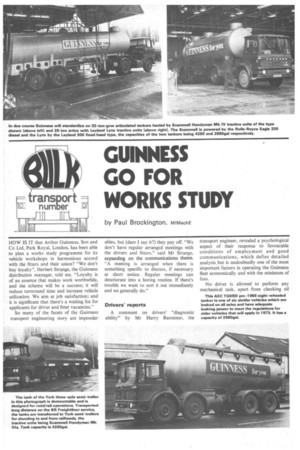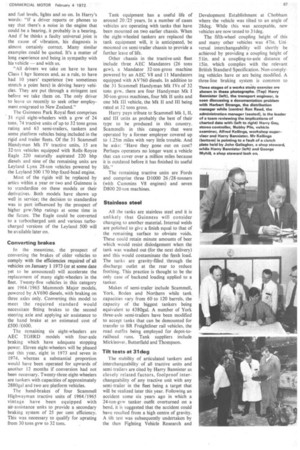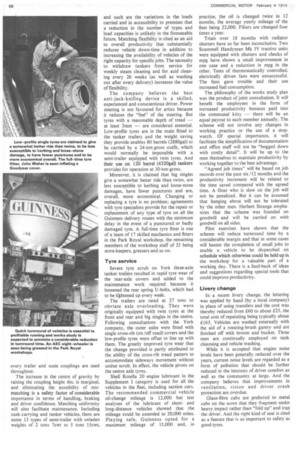GUINNESS GO FOR WORKS STUDY
Page 70

Page 71

Page 72

If you've noticed an error in this article please click here to report it so we can fix it.
by Paul Brockington, MINIechE
HOW IS IT that Arthur Guinness. Son and Co Ltd, Park Royal, London, has been able to plan a works study programme for its vehicle workshops in harmonious accord with the fitters and their union? "We don't buy loyalty", Herbert Strange, the Guinness distribution manager, told me. "Loyalty is of an essence that makes work worthwhile, and the scheme will be a success; it will reduce turnround time and increase vehicle utilization. We aim at job satisfaction; and it is significant that there's a waiting list for applicants for driver and fitter vacancies."
So many of the facets of the Guinness transport engineering story are imponder
ables, but (dare I say it?) they pay off. "We don't have regular arranged meetings with the drivers and fitters," said Mr Strange, expanding on the communications theme. "A meeting is arranged when there is something specific to discuss, if necessary at short notice. Regular meetings can deteriorate into a boring routine. If there's trouble we want to sort it out immediately and we generally do."
Drivers' reports A comment on drivers' "diagnostic ability" by Mr Harry Bannister, the transport engineer, revealed a psychological aspect of their response to favourable conditions of employment and good communications, which defies detailed analysis but is undoubtedly one of the most important factors in operating the Guinness fleet economically and with the minimum of fuss.
No driver is allowed to perform any mechanical task, apart. from checking oil and fuel levels, lights and so on. In Harry's words: "If a driver reports or phones to say that there's a noise in the engine that could be a bearing, it probably is a bearing. And if he thinks a faulty universal joint is the cause of vibration, his diagnosis is almost certainly correct. Many similar examples could be quoted. It's a matter of long experience and being in sympathy with his vehicle — and with us.
"All drivers we take on have to have Class 1 hgv licences and, as a rule, to have had 10 years' experience (we sometimes stretch a point here) in driving heavy vehicles. They are put through a stringent test before we take them on. The only driver to leave us recently to seek other employment emigrated to New Zealand."
The Guinness Park Royal fleet comprises 31 rigid eight-wheelers with a gvw of 24 tons. 74 tractive units of up to 32 tons gross rating and 63 semi-trailers, tankers and some platform vehicles being included in the rigid and trailer fleets. Of the 31 Scammell Handyman Mk IV tractive units, 15 are 32-ton vehicles equipped with Rolls-Royce Eagle 220 naturally aspirated 220 bhp diesels and nine of the remaining units are • Leyland Lynx 28-ton vehicles powered by the Leyland 500 170 bhp fixed-head engine.
• Most of the rigids will be replaced by artics within a year or two and Guinness is to standardize on these models or their derivatives.. Both models have shown up well in service; the decision to standardize was in part influenced by the prospect of higher gvw /bhp ratings at some time in the future. The Eagle could be converted to a turbocharged unit and various turbocharged versions of the Leyland 500 will be available later on.
Converting brakes In the meantime, the prospect of converting the brakes of older vehicles to comply with the efficiencies required of all vehicles on January 1 1973 (or at some date yet to be announced) will accelerate the replacement of many eight-wheelers in the fleet. Twenty-five vehicles in this category are 1964/1965 Mammoth Major models, powered by AV690 diesels, with braking on three axles only. Converting this model to meet the required standard would necessitate fitting brakes to the second steering axle and applying air assistance to the hand brake at an estimated cost of E500 /£600.
The remaining six eight-wheelers are AEC TG8RD models with four-axle braking which have adequate stopping power. Eleven eight-wheelers will be phased Out this year, eight in 1973 and seven in 1974, whereas a substantial proportion would have been operated for upwards of another 12 months if conversion had not been necessary. Twenty-three eight-wheelers are tankers with capacities of approximately 2880gal and two are platform vehicles.
The hand-brakes of four Scammell Highwayman tractive units of 1964 /1965 vintage have been equipped with air-assistance units to provide a secondary braking system of 25 per cent efficiency. This was necessary to qualify for uprating from 30 tons gvw to 32 tons. Tank equipment has a useful life of around 20/25 years. In a number of cases vehicles are operating with tanks that have been mounted on two earlier chassis. When the eight-wheeled tankers are replaced the tank equipment will, it is anticipated, be mounted on semi-trailer chassis to provide a further lease of life.
Other chassis in the tractive-unit fleet include three AEC Mandators (26 tons gcw), a Mandator 32-ton-gross machine powered by an AEC V8 and 11 Mandators equipped with AV760 diesels. In addition to the 31 Scammell Handyman Mk IVs of 32 tons gvw, there are four Handyman Mk 1 30-ton-gross machines, four Mk II units and one Mk III vehicle, the Mk II and III being rated at 32 tons gross.
Harry pays tribute to Scammell Mk I, II, and HI units as probably the best of their type to be produced in this country. Scammells in this category that were operated by a former employer covered up to 1.25m miles with very little trouble. And he asks: "Have they gone out on cost? Perhaps operators no longer want a vehicle that can cover over a million miles because it is outdated before it has finished its useful life."
The remaining tractive units are Fords and comprise three D1000 26 /28-tonners (with Cummins V8 engines) and seven D800 20-ton machines.
Stainless steel
All the tanks are stainless steel and it is unlikely that Guinness will consider changing to another material. Internal welds are polished to give a finish equal to that of the remaining surface to obviate voids. These could retain minute amounts of beer which would resist dislodgement when the tank was washed out (for the next delivery) and this would contaminate the fresh load. The tanks are gravity-filled. through the discharge outlet at the rear to reduce frothing. This practice is thought to be the only case of backend loading applied to a tanker.
Makes of semi-trailer include Scammell, York, Boden and Northern while tank capacities vary from 60 to 120 barrels, the capacity of the biggest tankers being equivalent to 4380gal. A number of York three-axle semi-trailers have been modified to accept tanks that can be demounted for transfer to BR Freightliner rail vehicles, the road outfits being employed for depot-torailhead runs. Tank suppliers include Mickleover, Butterfield and Thompson.
Tilt tests at 31deg
The stability of articulated tankers and interchangeability of all tractive units and semi-trailers are cited by Harry Bannister as closely related factors, foolproof interchangeability of any tractive unit with any semi-trailer in the fleet being a target that will be realized later this year. Following an accident some six years ago in which a 24-ton-gvw tanker outfit overturned on a bend, it is suggested that the accident could have resulted from a high centre of gravity. A tilt test was subsequently undertaken by the then Fighting Vehicle Research and Development Establishment at Chobham where the vehicle was tilted to an angle of 28deg. While this was acceptable, new vehicles are now tested to 31deg.
The fifth-wheel coupling height of this and many other vehicles was 471n. Universal interchangeability will shortly be achieved by providing a coupling height of 51in. and a coupling-to-axle distance of 15in. which complies with the relevant British Standard Specification. Non-complying vehicles have or are being modified. A three-line braking system is common to every trailer and susie couplings are used throughout.
The increase in the centre of gravity by raising the coupling height 4in. is marginal, and eliminating the possibility of mismatching is a safety factor of considerable importance in terms of handling, braking and driver confidence. Matching uniformity will also facilitate maintenance. Including cask-carrying and tanker vehicles, there are some 13 types of semi-trailer with unladen weights of 2 tons 7cwt to 5 tons 15cvvt, and such are the variations in the loads carried and in accessibility to premises that a reduction in the number of types and load capacities is unlikely in the foreseeable future. Matching flexibility is cited as an aid to overall productivity that substantially reduces vehicle down-time in addition to increasing the availability of vehicles of the right capacity for specific jobs. The necessity to withdraw tankers from service for weekly steam cleaning and for acid cleaning every 26 weeks (as well as washing out after every delivery) increases the value of flexibility.
The company believes the best anti-jack-knifing device is a skilled, experienced and conscientious driver. Power steering is not favoured for artics because it reduces the "feel" of the steering. But tyres with a reasonable depth of tread — at least 3nun — are considered essential. Low-profile tyres are in the main fitted to the tanker trailers and the weight saving they provide enables 80 barrels (2880ga1) to be carried by a 24-ton-gross outfit, which would normally be impossible with a semi-trailer equipped with twin tyres. And their use on 120 barrel (4320gal) tankers provides for operation at 30-ton-gross.
Moreover, it is claimed that big singles give a somewhat better ride than twins, are less susceptible to kerbing and loose-stone damages, have fewer punctures and are, overall, more economical. Changing or replacing a tyre is no problem; agreements with tyre specialists provide for the repair or replacement of any type of tyre on all the Guinness delivery routes with the minimum delay in thern event of a punctured or badly damaged tyre. A full-time tyre fitter is one of a team of 17 skilled mechanics and fitters in the Park Royal workshop, the remaining members of the workshop staff of 25 being store-keepers, greasers and so on, Tyre service Severe tyre scrub on York three-axle tanker trailers resulted in rapid tyre wear of the rear-axle covers and added to the maintenance work required because it loosened the rear spring LI-bolts, which had to be tightened up every week.
The trailers are rated at 27 tons to obviate axle overloading. They were originally equipped with twin tyres at the front and rear and big singles in the centre. Following consultations with the York company, the outer axles were fitted with single cross-rib (on /off road) covers and the low-profile tyres were offset to line up with them. The greatly improved tyre wear that the change provided is partly attributed to the ability of the cross-rib tread pattern to accommodate sideways movement without undue scrub. In effect, the vehicle pivots on the centre axle tyres.
Shell Rotella 20 engine lubricant in the Supplement I category is used for all the vehicles in the fleet, including section cars. The recommended commercial vehicle oil-change mileage is 12,000 but test analyses of the lubricant of shortand long-distance vehicles showed that the mileage could be extended to 20,000 miles. Playing safe, Guinness opted for a maximum mileage of 15,000 and, in practice, the oil is changed twice in 12 months, the average yearly mileage of the fleet being 22,000. Filters are changed four times a year.
Trials over 18 months with radiator shutters have so far been inconclusive. Two Scammell Handyman Mk IV tractive units were equipped with shutters and checks of mpg have shown a small improvement in one case and a reduction in mpg in the other. Tests of thermostatically controlled, electrically driven fans were unsuccessful. The fans gave trouble and their use increased fuel consumption.
The philosophy of the works study plan was the product of joint consultation. It will benefit the employees in the form of increased productivity bonuses paid into the communal kitty — there will be an equal payout to each member annually. The scheme will not involve any changes in working practice or the use of a stopwatch. Of special importance, it will facilitate the simplification of documentation and office staff will not be "bogged down with costly detail". It will be up to the men themselves to maintain productivity by working together to the best advantage.
"Agreed job times" will be based on job records over the past six /12 months and the productivity increment will be related to the time saved compared with the agreed time. A fitter who is slow on the job will not be penalized. But it can be assumed that hanging about will not be tolerated by the other men. Herbert Strange emphasizes that the scheme was founded on goodwill and will be carried on with goodwill on all sides.
Pilot exercises have shown that the scheme will reduce turnround time by a considerable margin and that in some cases will hasten the completion of small jobs to enable a vehicle to be dispatched on schedule which otherwise could be held up in. the workshop for a valuable part of a working day. There is a feed-back of ideas and suggestions regarding special tools that could improve productivity.
Livery change In .a recent livery change, the lettering was applied by hand (by a local company) in place of using transfers and the cost was thereby reduced from £60 to about £25, the total cost of repainting being typically about £165. Vehicles are washed externally with the aid of a rotating-brush gantry and are finished off with broom and bucket. Three men are continually employed on tank cleansing and vehicle washing.
While it is accepted that engine noise levels have been generally reduced over the years, current noise levels are regarded as a form of pollution that should be further reduced in the interests of driver comfort as well as the community at large. And the company believes that improvements in ventilation, vision and driver crash protection are overdue.
Glass-fibre cabs are preferred to metal cabs on the score that they fragment under heavy impact rather than "fold up" and trap the driver. And the right kind of seat is cited as a feature that is as important to safety as good tyres.














































































































































